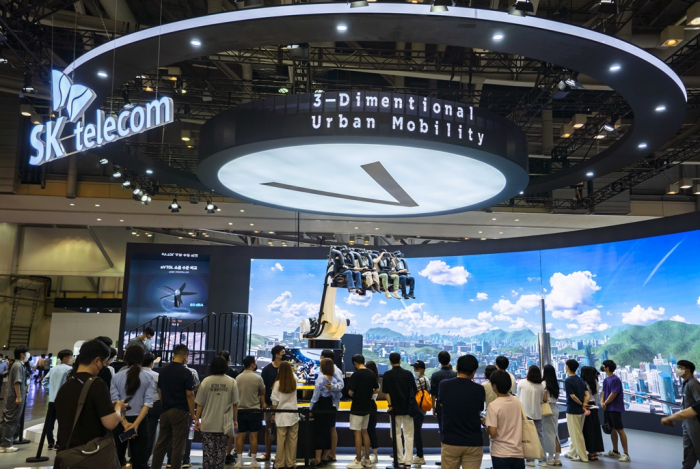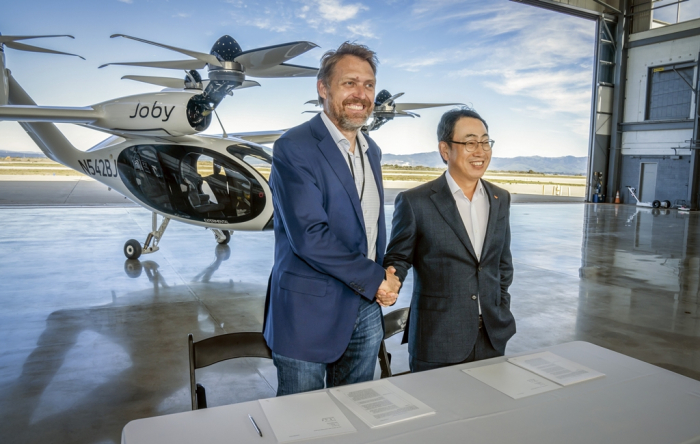Future mobility
SK Telecom to take lead in UAM biz with telco know-how
Korea expects the global UAM market to soar to $61.5 bn by 2030 and further to $609 bn by 2040 from forecast $6.1 bn in 2023
By Jul 17, 2022 (Gmt+09:00)
2
Min read
Most Read
LG Chem to sell water filter business to Glenwood PE for $692 million


Kyobo Life poised to buy Japan’s SBI Group-owned savings bank


KT&G eyes overseas M&A after rejecting activist fund's offer


StockX in merger talks with Naver’s online reseller Kream


Mirae Asset to be named Korea Post’s core real estate fund operator



SK Telecom plans to expand its services into air mobility from smartphones and the internet of things (IoT), said its Chief Development Officer Ha Min-yong at the Busan International Motor Show where the carrier showcased its UAM technology.
“We aim to evolve into a leading connected intelligence company that smartly links UAM aircraft, vertiports – platforms for takeoff and landing – and existing transportation on the ground,” Ha told reporters.
SK Telecom, the only company among those that target the UAM market to participate at the motor show in South Korea’s No. 2 city, exhibited a small-sized model of electric vertical take-off and landing (eVTOL) aircraft and allowed visitors to experience UAM flights by taking a ride on a giant robot arm simulator.
ENORMOUS POTENTIAL
The global UAM market is expected to surge to $61.5 billion by 2030 – at the time of initial commercialization – and further to $609 billion by 2040 from a forecast $6.1 billion in 2023, according to the Ministry of Land, Infrastructure and Transport.
The South Korean UAM market is also predicted to grow to 13 trillion won ($9.8 billion) by 2040 with services such as operations, control, communication and service platforms making up 75%.
“That will open up enormous potential for Korean companies if we establish a world-leading service system through Korea’s advanced ICT infrastructure,” Ha stressed.
SK Telecom has been actively developing UAM technology and investing in the sector since late last year when it set up a task force team directly under CEO Ryu Young-sang. It began eyeing the UAM business in February 2019.
JOINING HANDS WITH JOBY AVIATION
SK Telecom in February this year signed an agreement with Joby Aviation Inc., a California-based electric passenger aircraft developer, to cooperate in the entire UAM business including the aircraft and service platforms.
The South Korean company said Joby currently has the most advanced technology among eVTOL aircraft makers around the world.

In May, SK Telecom applied for a transportation ministry-led UAM project alongside Hanwha Systems Co., Korea Airports Corp. and Korea Transport Institute, competing with other telecommunication service providers that teamed up with major companies such as Hyundai Motor Co.
The Ministry of Land, Infrastructure and Transport in February launched the K-UAM Grand Challenge, a large-scale demonstration project to commercialize UAM from 2025. The ministry plans to select participants in November of this year is scheduled to begin demonstration flights in open terrain next year.
“It is expected to be used only for the tourism, medical and logistics sectors in low-density areas in the early stages of commercialization,” said Ha. “Its role will be expanded into public transportation once the industry builds up experience and more people accept the new transportation method.”
Write to Seung-Woo Lee at leeswoo@hankyung.com
Jongwoo Cheon edited this article.
More to Read
-
 Future mobilityLG’s telecommunication unit joins UAM race in Korea
Future mobilityLG’s telecommunication unit joins UAM race in KoreaMay 11, 2022 (Gmt+09:00)
4 Min read -
 Artificial intelligenceSK Telecom’s bet on air mobility, metaverse in full display at World IT Show
Artificial intelligenceSK Telecom’s bet on air mobility, metaverse in full display at World IT ShowApr 18, 2022 (Gmt+09:00)
3 Min read
Comment 0
LOG IN


